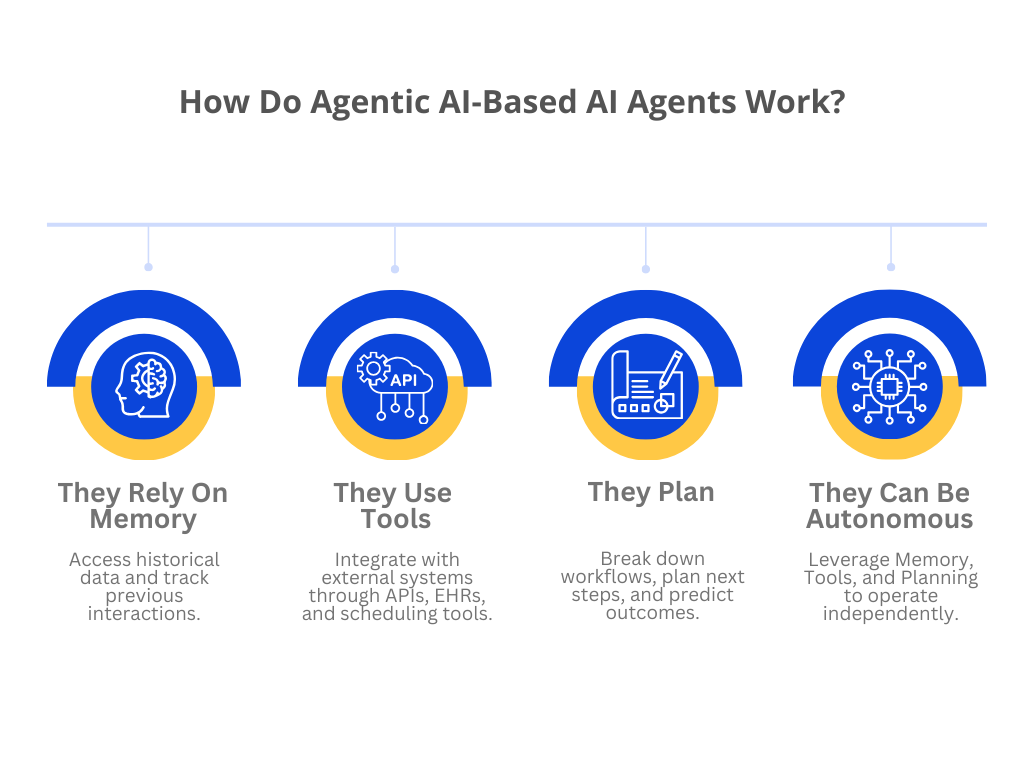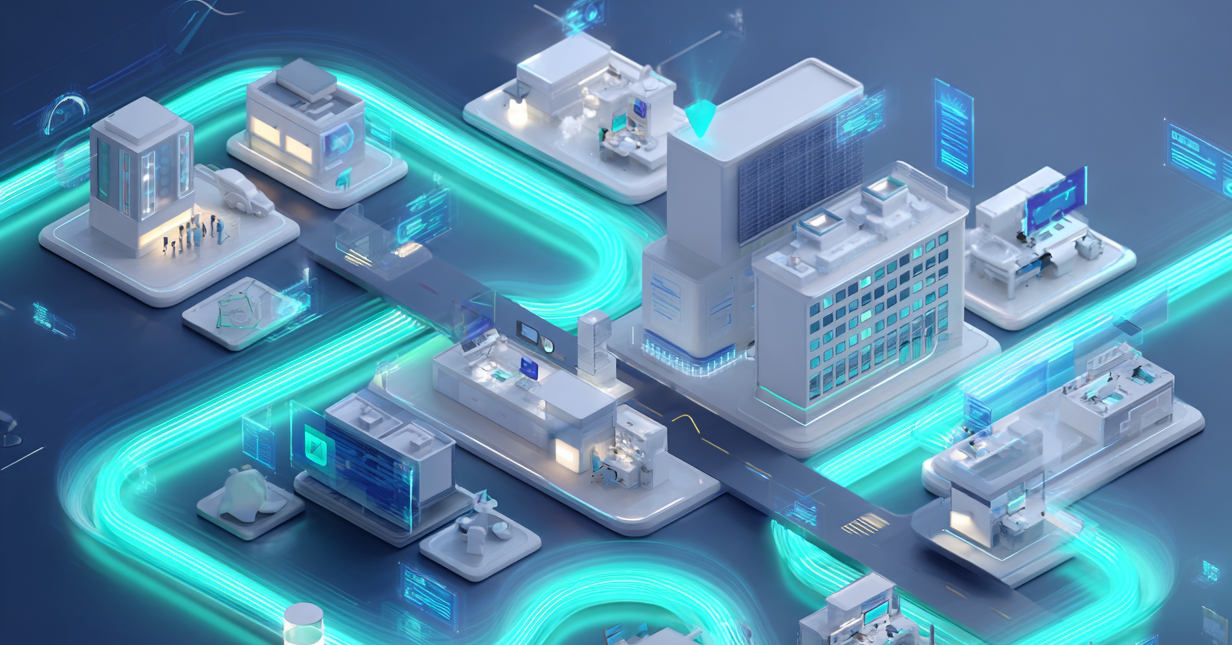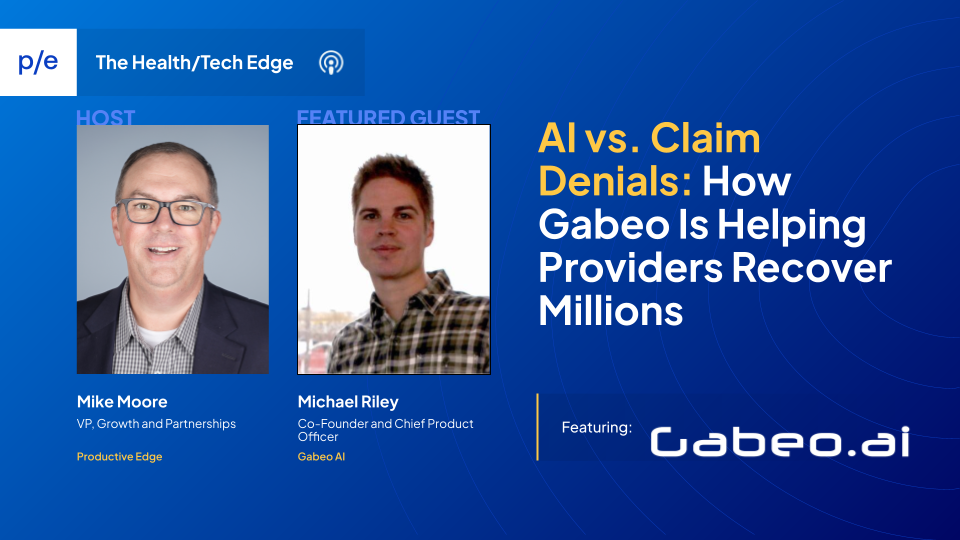In our inaugural post of the Mastering AI Agents in Healthcare blog series, we explore the fundamentals of agentic AI, navigating how AI agents differ from traditional AI systems. We'll discuss their autonomous capabilities, real-time decision-making, and potential to revolutionize healthcare operations. This foundation sets the stage for understanding the transformative power of AI agents in subsequent posts.
AI That Takes Action - Not Just Orders
Artificial Intelligence (AI) is no longer just a tool you use—it’s evolving into something much more with Agentic AI. Unlike traditional systems that only follow instructions, Agentic AI acts independently: orchestrating tasks, making decisions, and adapting in real-time.
This shift couldn’t be more important for healthcare, where inefficiencies and rising costs put pressure on both payers and providers. From streamlining workflows to improving collaboration, Agentic AI steps in to handle the complexity, so your team can focus on what matters most—delivering better care.
With AI everywhere in the news, you might ask: What makes Agentic AI different? And why is now the right time to make the leap? Let's take a closer look at how it can help you solve the challenges you're facing right now.
What is Agentic AI?
Agentic AI refers to an intelligent architecture designed to create AI Agents—autonomous systems that not only generate responses but also actively execute workflows, manage data, and plan tasks to achieve specific goals.
While traditional AI is often designed for specific tasks, agents in Agentic AI act independently, operating across processes to reduce manual workload and alleviate data fragmentation.
.png?width=1024&height=768&name=AI%20Agent%20functions%20(1).png)
In healthcare, AI agents can handle the following tasks:
- Claims Processing: AI agents autonomously review claims, verify documentation, and resolve discrepancies, reducing approval times by 30%.
- Care Coordination: AI agents synthesize fragmented data, ensuring high-risk patients receive timely interventions and reducing unnecessary readmissions.
- Authorization Requests: Agents analyze eligibility, flag bottlenecks, and expedite prior authorizations, reducing manual review times by 40%.
It's important to note that AI agents can enhance—but not completely replace—automation for complex tasks. These smart agents bring together information, resolve workflow obstacles, and adjust on the fly to meet the needs of processes like care management and claims processing.
How Agentic AI Works
AI agents operate independently, observing their environment, processing information, and making decisions aligned with their objectives. They take actions to achieve these goals while continuously learning and adapting through feedback, simulating human-like thinking to solve complex problems—all without needing direct human involvement.

Let’s break down how these AI agents function and why they’re such a game-changer.
Orchestrating Tasks
The agent autonomously interprets a request and orchestrates the necessary actions. It doesn't just offer recommendations—it takes charge, interpreting requests and carrying out the necessary actions autonomously. In care coordination, for example, the agent proactively pulls data from multiple sources, identifies care gaps, and schedules follow-ups without waiting for human input.
By reducing the need for manual intervention, these agents ensure seamless care for high-risk patients, improving continuity and giving your team more time to focus on face-to-face patient care.
Memory Retention
Unlike traditional AI, which operates in isolated interactions, Agentic AI retains and recalls important information over time—such as patient history and care preferences. This allows agents managing chronic care coordination to remember key details from previous visits and apply that context to future interventions, ensuring more personalized and consistent care without missing a beat.
.png?width=1000&height=400&name=Memory%20retention%20(2).png)
Tool Integration
Agents connect to APIs, databases, and real-time systems, acting as intermediaries between disparate platforms. These are referred to as Tools. For instance, an agent might automatically access medical records and financial databases to gather all relevant information, simplifying care plan approvals and reducing the need for manual input.
.png?width=1000&height=400&name=AI%20Agent%20Tool%20Integration%20(1).png)
Workflow Planning
Agentic AI excels at managing complex, multistage workflows. In care management, agents can break down tasks into manageable steps. For example, an agent managing a patient’s post-discharge care proactively coordinates with clinicians, schedules follow-up appointments, and tracks patient outcomes to ensure care continuity. This reduces administrative burden, ensures timely interventions, and improves patient outcomes.
.png?width=800&height=400&name=Yellow%20Minimalist%20and%20Simple%20Corporate%20Business%20Plan%20%26%20Process%20Data%20Graph%20(1).png)
How Agentic AI Utilizes Large Language Models (LLMs)
LLMs significantly enhance the capabilities of Agentic AI, enabling these systems to handle complex healthcare challenges autonomously with enhanced accuracy.
Here’s how LLMs integrate seamlessly with the core components:
- Orchestrator: LLMs process vast amounts of unstructured data, such as claim notes or patient histories. The LLM interprets this input, and the agent executes tasks autonomously, such as deciding the next best action in claims processing.
- Memory: With memory integration, LLMs retain critical context over time. For example, when tracking ongoing patient care, the LLM helps recall prior care adjustments, ensuring the agent makes informed decisions.
- Tools: LLMs enable agents to interpret data from multiple tools. For example, the LLM guides interpretation to ensure coherent decision-making across systems in managing prior authorizations.
- Planning: LLMs assist agents in planning multistage workflows. The agent predicts what tools are needed and anticipates next steps in tasks like managing care plans, coordinating between teams, and reducing hospitalizations.
LLMs, like GPT models, enhance cognitive capabilities, enabling agents to process context and data. Depending on organizational needs, these models can be fine-tuned for healthcare-specific tasks, hosted privately for greater control, or customized using open-source versions. Depending on deployment needs, LLMs can be:
- Public base models that are fine-tuned for healthcare-specific tasks.
- Private LLMs can be hosted in secure, private cloud environments for greater control.
- Open-source LLMs that can be customized and run entirely on your infrastructure.
This versatility allows payers and providers to balance performance, privacy, and compliance.
Agentic AI and Multi-Agent Systems
A compelling application of Agentic AI is multi-agent systems, where multiple specialized agents work together on separate but interconnected tasks. For example, in care management, one agent might handle patient data synthesis while another automates care plan updates. They communicate to ensure that tasks are aligned, creating an integrated system that operates across multiple workflows simultaneously. It is fascinating that each agent could use different technologies for its purpose, allowing you to apply best-in-class emerging technologies for the right task.

By deploying multi-agent systems, healthcare organizations can ensure that different parts of their operations are running efficiently without bottlenecks or information silos.
Practical Examples of Agentic AI in Action
1. Claims Processing
AI agents assist in reviewing claims, verifying documentation, identifying discrepancies, and flagging issues. AI agents can send non-approvals or denials to humans for further review, assist clinical teams in their review of the claim ensuring fairness and regulatory compliance.
Using real-time data and predictive analytics, these agents streamline workflows, minimize approval times, and reduce administrative burdens. By eliminating bottlenecks, they enhance operational efficiency and allow teams to focus more on patient care and other high-value activities, driving better outcomes and improved service delivery
AI agents can cut review times by 30% by streamlining approval processes using real-time data and predictive analytics.
Agent’s Role: The agent uses memory to track claim history, accesses APIs to verify eligibility, and plans necessary steps to expedite approvals, ensuring smoother claim workflows.
2. Care Coordination
Care teams often struggle with fragmented information across different systems, which can result in gaps in patient management. AI agents work by gathering data from electronic health records (EHRs), care management platforms, and scheduling systems, allowing them to streamline workflows efficiently.
Agent’s Role: The agent knows how to invoke source-specific agents that retrieve various data points, synthesizing them to give a full picture. It predicts which high-risk patients need immediate intervention and automates collaboration across care teams. This reduces preventable readmissions and improves patient outcomes and overall efficiency.
3. Authorization Requests
AI agents handle prior authorizations by autonomously evaluating resource utilization, eligibility criteria, and required documentation. They flag potential bottlenecks in real-time, reducing the review process by 40% while providing transparency for both payers and providers.
Agent’s Role: The agent accesses patient and billing data, applies rules to check authorization eligibility, and executes the workflow autonomously without requiring manual intervention.
4. Data Reconciliation
For financial and operations teams, reconciling payment data from claims to outgoing provider payments can be a labor-intensive process prone to errors. AI agents automate this by cross-referencing claims data, provider records, and financial transactions, ensuring that payments match claims accurately. This reduces manual reconciliation work by 25%, improves accuracy, and helps detect any discrepancies.
Agent’s Role: The agent accesses financial databases, claim systems, and provider records, ensuring any inconsistencies in payment amounts or timing are automatically flagged and quickly resolved.
AI Agents Vs. Traditional AI
Some may wonder: Aren’t we already seeing AI handle these tasks? The answer lies in how Agentic AI components work together—creating a cohesive, proactive system rather than reactive automation. Let's take a closer look at the top three key differences between AI agents and traditional AI.
1. Beyond RPA Bots
While Robotic Process Automation (RPA) bots are rules-based and typically limited to predefined tasks, AI agents adapt dynamically. Agents can change strategies mid-process, interact with evolving data, and operate independently with little human input.
For example, An RPA bot might be programmed to log into a system and extract patient appointment data at the end of each day. In contrast, an AI agent could analyze this data in real time, adjusting schedules dynamically based on patient cancellations, emergency bookings, or overbookings. The AI agent adapts and adjusts workflows mid-process to optimize appointment schedules without human intervention.
2. Not Just a Chatbot
AI agents aren’t simple conversational bots. While chatbots offer basic interactions, agents can manage entire workflows. They orchestrate data synthesis, decision-making, and execution across complex healthcare processes. For example, a hospital chatbot might handle basic patient queries about operating hours or appointment statuses. However, an AI agent could manage an entire patient referral process. It could analyze the patient's medical history, schedule appointments with the right specialist, and follow up automatically post-visit to coordinate any required lab tests or further consultations, all based on evolving patient data and needs.
3. Multistage Workflows
Traditional AI typically focuses on one task at a time, but AI agents engage in planning—breaking down complex problems into smaller steps and managing each part of the process. They ensure continuity, whether tracking a patient’s care from hospital admission to post-discharge or processing a claim from submission to approval. For example, in traditional AI, a single step, such as reading a lab result, might be automated. However, an AI agent can manage a patient’s entire care journey. For example, from hospital admission, where it gathers patient data, to discharge planning, where it synthesizes input from multiple healthcare professionals, ensuring follow-up care is coordinated and documented. It ensures the entire process flows seamlessly, from data intake to follow-up visits, with every step adapted to patient changes in real-time.

Agentic AI Industry Momentum & Productive Edge AI Accelerators
Recent innovations from major tech players highlight the growing role of AI agents in healthcare. Google's latest insights emphasize the importance of integrating fragmented data for accurate, scalable AI applications in health operations. This aligns with Productive Edge's AI Accelerators, which streamline workflows by dynamically synthesizing real-time data, offering seamless integration with existing systems to drive efficiency. As healthcare organizations face rising costs, AI agents provide a timely, scalable solution.
- Microsoft, one of our trusted partners, recently introduced new autonomous agents that enhance team scalability by automating complex, multistep workflows. These agents work dynamically, scaling tasks across business operations with minimal human input.
- Salesforce is developing Agentforce, which integrates AI agents into customer relationship management (CRM) systems. These agents autonomously handle workflows like managing client data, automating routine tasks, and enabling deeper customer interactions through AI-driven decision-making.
- Crew AI and Langchain focus on leveraging agentic frameworks that integrate LLMs (Large Language Models) with external tools to enable AI agents to act autonomously in various business environments.
Productive Edge’s Accelerators build upon these innovations. By integrating Agentic AI frameworks, P/E’s accelerators are designed to deliver immediate value in healthcare by bringing AI agents to life. For example, our accelerators automate claims processing, care coordination, and member engagement tasks—cutting operational costs, improving workflow efficiency, and dynamically adapting to evolving data. Our approach leverages pre-defined workflows, real-time data tools, and dynamic decision-making, helping healthcare payers and providers harness the potential of AI without the need for complex system overhauls.
In this context, P/E’s AI Agent Accelerators act as a bridge, allowing healthcare organizations to capitalize on the latest advancements from significant tech players while delivering measurable improvements today.
Navigating the Rapidly Changing Agentic AI Landscape
From enabling smarter operations for payers to elevating patient-centric care for providers, Agentic AI is pivotal in addressing some of the healthcare industry’s most pressing challenges. It plays a critical role in improving risk stratification by identifying high-risk patients early, thereby enabling proactive care interventions. It can also tackle administrative burdens by automating repetitive tasks such as pre-authorizations, billing, and documentation, allowing healthcare professionals to focus more on patient care. Additionally, these AI agents can enhance decision-making processes by providing clinicians with real-time, evidence-based recommendations tailored to individual patient profiles.
The rapid advancement of Agentic AI solutions has led to a highly dynamic and competitive market landscape. Projections indicate a surge in the adoption of Agentic AI technologies, with the market expected to grow from USD 10 billion in 2023 to USD 48.5 billion by 2032. This growth is fueled by the increasing demand for automation, personalized care solutions, and operational efficiency.
Healthcare organizations must stay ahead by continuously evaluating and adopting the most suitable AI solutions to remain competitive and deliver optimal patient outcomes.
To help healthcare leaders do just that, we've developed a groundbreaking market research report, Navigating the Rapidly Emerging Agentic AI Vendor Landscape For Healthcare, combining strategic analysis with operational frameworks to:
- Highlight market trends and industry drivers shaping Agentic AI adoption.
- Outline payer and provider use cases for implementing Agentic AI in operational workflows.
- Present a comprehensive framework for comparing solution providers.
- Provide expert opinions and thought leadership to guide decision-making.
- Share vendor-specific roadmaps and projections for adopting future-ready solutions.
- Deliver an implementation roadmap and strategies for risk mitigation.
As the landscape evolves, the insights and strategies outlined in this complimentary report will serve as a vital resource for leaders looking to navigate the complexities of Agentic AI and drive transformative change within their organizations.
Why Healthcare Leaders Should Embrace Agentic AI Today
With payers and providers facing increased pressures—from administrative inefficiencies to rising operational costs—Agentic AI offers a clear path forward. These agents can reduce claims processing times, streamline care coordination, and provide real-time decision support, improving patient outcomes and operational efficiency.
The real power of Agentic AI lies in its ability to integrate seamlessly with existing platforms—even those like Epic, which may not yet offer full AI capabilities. Why wait for future innovations when you can deploy these agents now and capture tangible benefits from day one?
Agentic AI isn’t just a passing trend—it’s the future of healthcare efficiency. With advanced features like memory retention, predictive planning, tool integration, and autonomous action, these agents transform fragmented workflows into coordinated, proactive processes that drive immediate impact.
Resources to Embrace AI Agents with Confidence
Whether you're embarking on your AI journey or seeking to scale your Agentic AI initiatives, having the right tools and strategies is critical to your success. At Productive Edge, we've meticulously curated a comprehensive resource hub to equip you with the insights and frameworks needed to harness this technology with confidence at every stage of your transformation.
Build a Solid Foundation
This article provides a great starting point for understanding AI agents, but there’s more to explore. Dive into these curated resources for deeper insights and a more comprehensive understanding.
- Demystifying AI Agents and Agentic AI eBook: A further exploration of AI agents, their role in transforming care coordination, claims management, and chronic disease management, and prior authorization, and real-world payer and provider-focused examples.
- How Agentic AI Can Drive Innovation in Value-Based Care Guide: A comprehensive guide packed with strategic insights and actionable use cases for leveraging AI to optimize operations and manager the complexities of VBC.
- How to Transform Care Transitions with Multi-Agent Systems Guide: A close look into how multi-agent systems powered by Agentic AI streamline healthcare transitions through strategic coordination.
- How to Transform Revenue Cycle Management with Agentic AI Guide: Discover how Agentic AI can reduce administrative burdens, improve cash flows, and empower your RCM teams.
See Agentic AI in Practice
Having a deeper understanding of AI agents, it's time to explore their real-world impact.
- Transforming Utilization and Care Management with Agentic AI Case Study: See how a leading national health payer partnered with Productive Edge to implement Agentic AI to tackle operational inefficiencies within utilization and care management and uncover millions in savings.
Deploying AI Agents in Your Organization
Now that you have a clearer understanding of AI’s potential in healthcare and a growing interest in implementing AI agents, it’s time to take the next step. Explore key strategic insights and actionable roadmaps to successfully integrate AI agents into your organization and drive meaningful transformation:
- Navigating the Rapidly Emerging Agentic AI Vendor Solutions Landscape Report: A comprehensive market research report packed with actionable insights and use cases to help healthcare leaders evaluate, adopt, and scale Agentic AI to rapidly tackle the healthcare cost crisis.
- Agentic AI Playbook for Healthcare Operations and IT Leaders: A strategic roadmap to adopting Agentic AI effectively, prioritizing high-impact use cases and turning existing investments into tangible value.
- AI Action Planning Workshop: A free expert-led workshop to help you identify your biggest cost inefficiencies and get a tailored AI roadmap with ROI-driven opportunities.
To continue your journey to mastering AI agents, read the next blog in our blog series Rewiring Care Transitions with Multi-Agent Systems Powered by Agentic AI.

.png?width=1000&height=400&name=ai%20agent%20workflow%20diagram%20(1).png)



